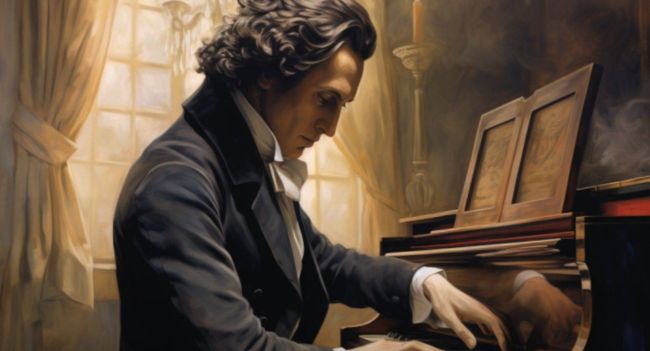The Chopin Prelude in E minor is widely considered one of the best piano pieces ever written. Composed by Frederic Chopin in 1839, this piece has been performed by countless pianists and has become a staple in the repertoire of many classical musicians. Its haunting melody and intricate harmonies have captivated audiences for generations, making it a timeless masterpiece.
Prelude in E Minor: An Overview
The Prelude in E minor is a perfect example of Chopin’s unique style, which blends elements of classical and romantic music. Its melancholic melody and delicate phrasing reflect the composer’s own struggles with illness and heartbreak, while its technical demands showcase his virtuosic piano skills. The piece is also notable for its use of rubato, a technique that allows the performer to stretch and compress the tempo for expressive effect.
This famous piano piece is actually a Largo movement, which means it should be played at a slow, leisurely pace. The piece is also marked dolce, which means it should be played in a sweet and delicate way.
The Prelude in E Minor is often used as a study piece for pianists who are learning to express emotions through its execution. It’s a difficult piece to play, as it requires great control and delicacy to bring out the subtle nuances of the melody. However, with practice, it can be a rewarding piece to play and is sure to leave a lasting impression on the audience.
Musical Analysis of Chopin’s Prelude in E Minor
The opening section of the prelude is marked by a slow and mournful melody. The melody is played in the right hand while the left hand provides a simple accompaniment. The melody is characterized by its use of chromaticism, which gives the piece its melancholic feel. The opening section ends with a cadence that leads into the middle section.
The middle section of the prelude is marked by a change in tempo and mood. The melody becomes more lively and playful, with a faster tempo and a more complex rhythm. The middle section is in the key of G major, which provides a contrast to the opening section in E minor. The middle section ends with a return to the opening melody, which leads into the closing section.
The closing section of the prelude is a repetition of the opening section, with some slight variations. The melody is played with more intensity and emotion, and the chromaticism is more pronounced. The closing section ends with a final cadence that brings the piece to a close.
The Importance of Chopin’s Prelude in E Minor in Piano Literature
One of the reasons why Chopin’s Prelude in E Minor is so important in piano literature is its expressive power. Chopin was a master of expressing emotions through his music, and this piece is no exception. This incredible piano piece is deeply emotional music that can evoke a range of feelings in the listener, from sadness to hope and joy.
Finally, the Prelude in E Minor is important because of its influence on other composers. Many composers have been inspired by Chopin’s work, and his Prelude in E Minor has been the subject of many adaptations and variations. The piece has become a staple of the piano repertoire and has helped to shape the course of piano music.
Tips for learning the Prelude in E Minor
Learning and performing this piece requires a lot of dedication, patience and skill. Here are some tips to help you master this masterpiece.
Start Slowly: Begin by practicing each hand separately at a slow tempo. Focus on playing the correct notes and rhythms accurately.
Pay Attention to Dynamics: The Prelude in E Minor has a lot of dynamic contrasts, so it’s essential to pay attention to them. Work on bringing out the melody and playing the accompaniment softly.
Practice in Sections: Break the piece down into smaller sections and practice each section until you can play it smoothly. Then, gradually piece the sections together.
Use the Pedal Sparingly: The pedal can add a lot of color and depth to the piece, but it can also muddy the sound if used excessively. Use the pedal sparingly and only when necessary.
Focus on the Emotion: The Prelude in E Minor is a deeply emotional piece, so it’s essential to convey that emotion in your performance. Focus on bringing out the melody and playing with expression.
Maintain a Steady Tempo: The Prelude in E Minor can be played at different tempos, but it’s crucial to maintain a steady tempo throughout the piece. Don’t rush or slow down in the middle of the piece.
Use Dynamics to Create Contrast: The Prelude in E Minor has a lot of dynamic contrasts, so it’s essential to use them to create contrast and interest in your performance.
End with Confidence: The ending of the Prelude in E Minor is quiet and delicate, so it’s essential to end with confidence and control. Practice the ending until you can play it smoothly and confidently.
Conclusion on the Prelude in E minor
One of the reasons the Prelude in E minor is so popular is its accessibility. It’s a relatively short piece, at just over two minutes, and its simple but powerful melody is easy to memorize. This makes it a popular choice for both beginners and advanced pianists.
Another factor contributing to the piece’s popularity is the range of emotions it evokes. The melancholy opening notes give way to a more hopeful middle section, before returning to the somber theme. This emotional journey resonates with listeners and has made the Prelude in E minor a staple of the classical music repertoire.
